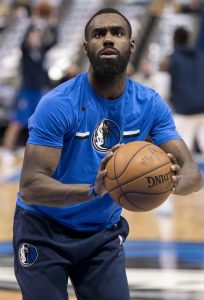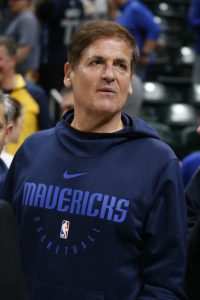Hoops Rumors is previewing the 2020 offseason for all 30 NBA teams. We’re looking at the key questions facing each club, as well as the roster decisions they’ll have to make this fall. Today, we’re focusing on the Philadelphia 76ers.
Salary Cap Outlook
The Sixers will enter the 2020 offseason with one of the NBA’s most expensive rosters — the club has more than $142MM committed to just nine players so far in 2020/21, eliminating the possibility of cap room and making Philadelphia a near-lock to be a taxpayer.
Barring major cost-cutting moves, the 76ers would have the taxpayer mid-level exception ($5.72MM) at their disposal in free agency.
Our full salary cap preview for the Sixers can be found right here.
Roster Decisions To Watch
Options:
- None
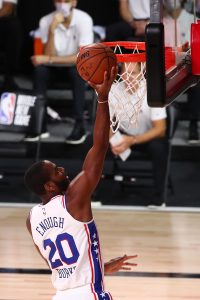
Non-Guaranteed Contracts:
Two-Way Contracts:
Free Agents:
2020 Draft Assets
First Round:
Second Round:
- No. 34 overall pick
- No. 36 overall pick
- No. 49 overall pick
- No. 58 overall pick
As has often been the case over the last few years, the Sixers have no shortage of draft picks available.
Philadelphia gave up its own 2020 first-rounder (No. 19) to acquire Tobias Harris from the Clippers in 2019, but the club has the Thunder’s first-round pick at No. 21 as a result of a Jerami Grant trade back in 2016. That selection, which had been top-20 protected, was sent to Orlando in 2017 for the rights to draft Anzejs Pasecniks before being traded back to Philadelphia in 2019 for Markelle Fultz.
In the second round, the Sixers have their own pick at No. 49, as well as the Hawks’, Knicks’, and Lakers’ selections.
Philadelphia got Atlanta’s pick (No. 34) when the Hawks moved up for Bruno Fernando in last year’s draft; the Knicks pick at No. 36 was acquired back in 2015 when New York traded for Willy Hernangomez‘s draft rights; and the Lakers’ pick (No. 58) was originally dealt to Orlando before being flipped to the Sixers at the 2020 deadline for James Ennis.
Three Key Offseason Questions
1. What will the decision-making structure look like going forward?
Following a disappointing season, the Sixers wasted no time in firing head coach Brett Brown once they were eliminated from the playoffs. Around that same time, reports suggested that the team also planned to make some changes to its front office personnel and structure.
Since the departure of former head of basketball operations Bryan Colangelo in 2018, the 76ers’ front office has taken a collaborative approach to decision-making, but general manager Elton Brand said at season’s end that he and the club felt as if “the collaboration days didn’t work.”
The stage seemed set for the Sixers to either hire a president of basketball operations a level above Brand or to empower Brand by giving him the final say on personnel decisions. Instead, there was little clarity on Philadelphia’s front office plan for several weeks while the team was searching for its new head coach.
Identifying and hiring Brown’s replacement was supposed to be Brand’s responsibility, but team ownership was said to be heavily involved in the process. When the Sixers ultimately hired Doc Rivers, Jason Dumas of KRON4 News reported that team ownership had initially wanted Mike D’Antoni while Brand preferred Tyronn Lue — when Rivers became available, he represented a candidate that both sides agreed upon.
The hiring of Rivers further muddies the waters of the Sixers’ front office hierarchy. Rivers was formerly the Clippers’ president of basketball operations, and when he was asked in his introductory presser with the Sixers about personnel decisions, he said that he and Brand will “work together.” That sounds a lot like the “collaborative” approach that Brand said in August wasn’t working for the franchise.
Having too many cooks in the kitchen on major roster decisions could complicate trade talks and create other problems for the Sixers in the future. It would be in the organization’s best interests to have co-owners Josh Harris and David Blitzer clearly define the front office hierarchy to avoid any confusion going forward, since significant roster decisions are on the horizon.
It sounds like the team is working toward that goal, having reportedly started interviewing candidates for at least one executive role below Brand.
2. How invested are the Sixers in the Ben Simmons/Joel Embiid duo?
Shortly after the 76ers’ 2019/20 season came to an end, Brand declared that the team had no intention of trading either Simmons or Embiid. The plan, according to Brand, is to put together a roster that will better complement those two stars.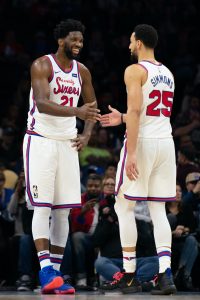
That approach comes as no surprise. When NBA teams bottom out like Philadelphia did during their infamous “Process,” the goal is to land a superstar-caliber player who can lead the franchise back to contention. Simmons and Embiid have their flaws, but they fit that criteria — they each have All-NBA berths under their belts and rank among the NBA’s best players at their respective positions. They’re also just 24 and 26 years old, respectively, so they have room to continue improving.
The problem, of course, is that their offensive styles don’t fit together as naturally as you’d like from your two stars. Simmons is a monster in transition, but still has little to no range on his jump shot, creating floor-spacing issues that clog the lane for Embiid, arguably the NBA’s best low-post scorer.
The duo’s mismatched nature has had some factions of NBA fans – in Philadelphia and elsewhere – clamoring for a trade involving one of the two players, since it’d be fascinating to see what they could do with their own teams built around their strengths.
For now though, the 76ers’ plan is to see if Rivers is capable of unlocking the potential of the Simmons/Embiid pairing. After all, it was just a puzzle that Brown was incapable of solving, then trading either player would be premature and short-sighted.
Still, while a Simmons or Embiid trade may not be in the cards this offseason, the Sixers need to start thinking about how long they’re committed to trying to make the marriage work. Even after the 2020/21 season, Embiid will have two more years on his contract and Simmons will be locked up for four seasons. Philadelphia could extract a substantial return for either player and could target packages headlined by players who would better suit their roster.
3. Can the Sixers find a favorable deal involving Tobias Harris or Al Horford?
If Simmons and Embiid are off the table, that means the Sixers’ best chance to shake up their roster this fall will involve moving one of their two other big-money contracts. Those deals belong to Harris, who still has four years and $147MM left, and to Horford, who has three years and $81MM remaining, though his final season is just partially guaranteed.
Neither of those players represents a positive asset right now. Harris remains a solid contributor, but with an annual salary of nearly $37MM over the next four years, he’s being paid as if he can be a top-two player on a title contender, which overstates his value.
As for Horford, he didn’t end up being a great fit alongside Embiid and it’s probably safe to say he’s past prime at age 34. His production won’t necessarily fall off a cliff, but his .450 FG% in his first season as a Sixer represented a career low, and his once-elite defensive skills will likely continue to fade as he enters his mid-30s and loses a step.
Although their trade value will be hurt by their exorbitant salaries, Harris and Horford could appeal to a team looking to get rid of an oversized contract of its own. That’s why Chris Paul has so frequently been cited as a potential trade target for Philadelphia.
Paul only has two years left on his contract, but his per-year salary during that time (approximately $42.8MM) is even higher than Harris’ or Horford’s. His play-making and shot-making abilities would also be a nice fit on a Sixers roster that could use a little help on both fronts.
Philadelphia native Kyle Lowry is also the sort of player the Sixers would presumably love to target. His game is similar to Paul’s and he’s even more affordable (one year at $30.5MM), though the Raptors presumably won’t be nearly as motivated to move him as the Thunder would be to find a taker for Paul.
Buddy Hield‘s is another name that has popped up frequently in 76ers-related trade speculation. He’s reportedly not thrilled with his situation in Sacramento and has liked social media posts linking him to Philadelphia. If the Sixers are targeting outside shooting, it’d be hard to do much better than Hield, who has made 41.1% of 6.7 three-point attempts per game since entering the league in 2016. His contract, worth $86MM over four years, plus incentives, isn’t necessarily a bargain, but it’s more team-friendly than Horford’s or Harris’.
Of those two Sixers contracts, Horford’s – which is shorter-term and less expensive than Harris’ – may be easier to move. Trading Horford rather than Harris probably also makes more sense for the Sixers from an on-court perspective, since it’s easier to find reliable backup centers on the cheap than it is to find productive wings.
Still, even if the 76ers’ top target is a mid-30s veteran with an oversized contract like Paul, it will take more than Horford to get a deal done. To acquire any sort of starting-caliber player, Philadelphia will have to be prepared to dip into its pool of future draft picks.
Information from Basketball Insiders and ESPN was used in the creation of this post. Photos courtesy of USA Today Sports Images.
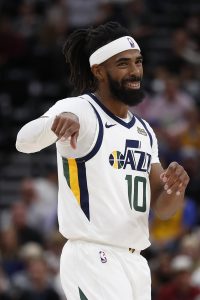
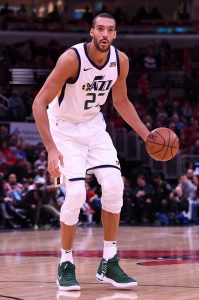 Mitchell’s next deal will also be a little more cost-controlled than Gobert’s could be. Even with an All-NBA berth next season, Mitchell can’t sign a rookie scale extension exceeding 30% of the cap. Due to Gobert’s All-NBA nods and DPOY awards, he has qualified for a veteran extension that can be worth up to 35% of the cap in 2021/22.
Mitchell’s next deal will also be a little more cost-controlled than Gobert’s could be. Even with an All-NBA berth next season, Mitchell can’t sign a rookie scale extension exceeding 30% of the cap. Due to Gobert’s All-NBA nods and DPOY awards, he has qualified for a veteran extension that can be worth up to 35% of the cap in 2021/22.

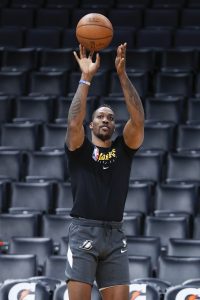 During their run to the NBA Finals, the Lakers have matched up with talented opposing centers such as
During their run to the NBA Finals, the Lakers have matched up with talented opposing centers such as 